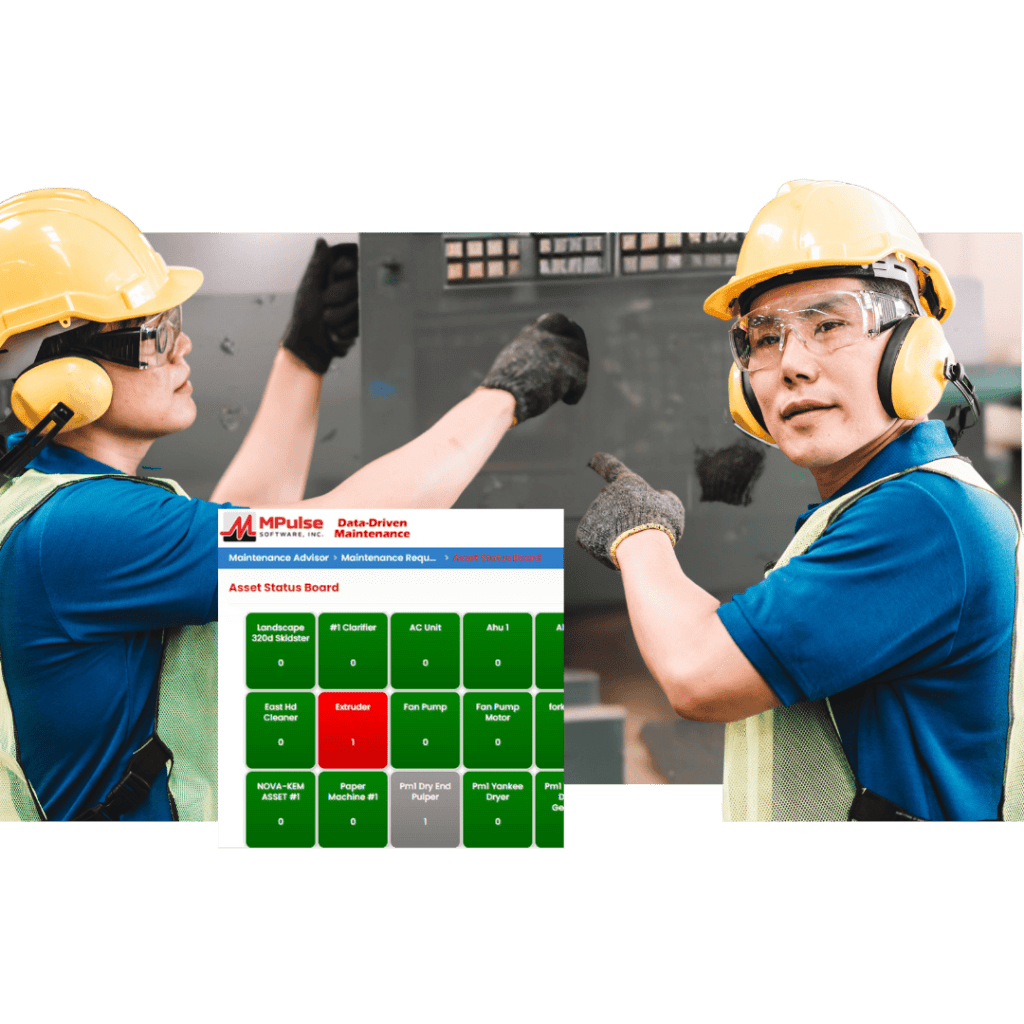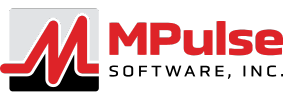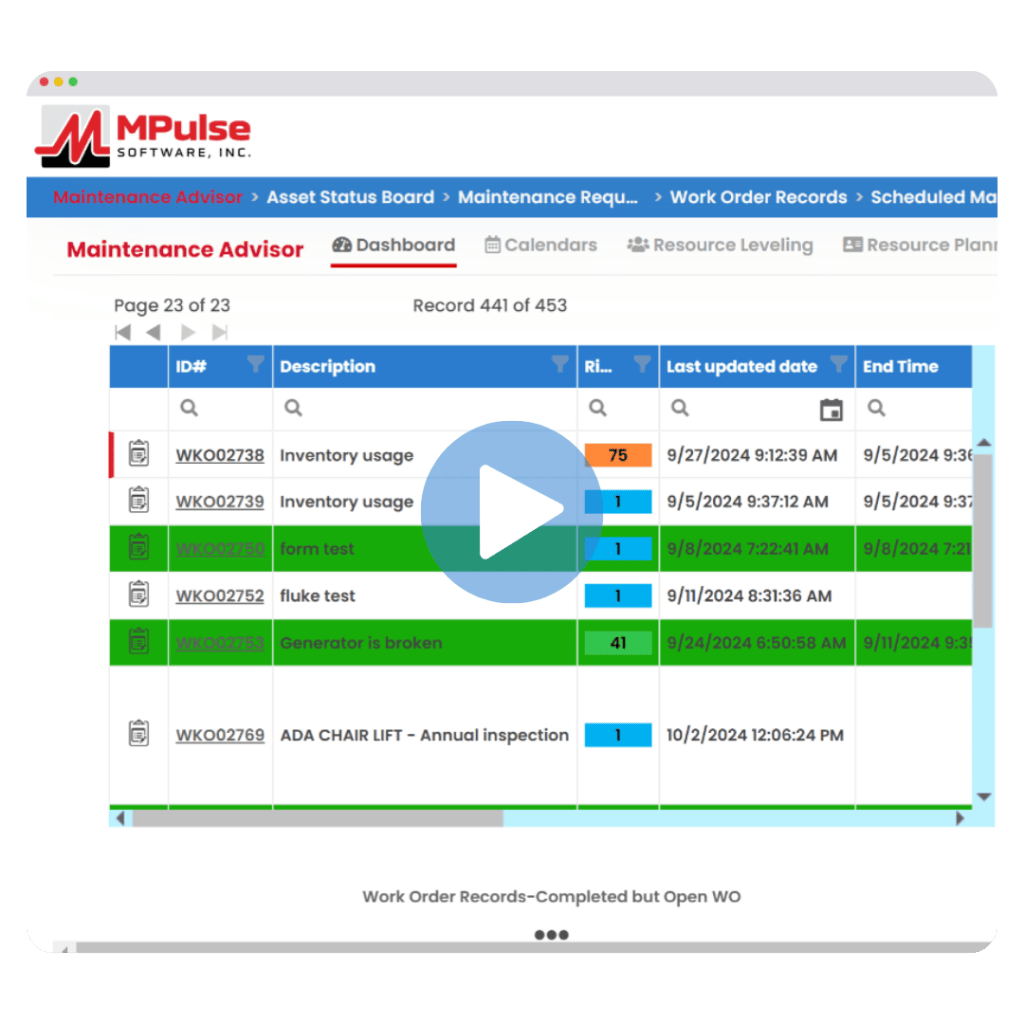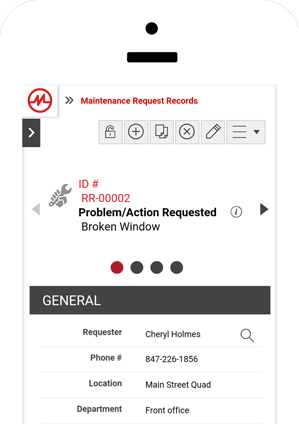Your All-in-One Asset Management Software

Take Control of Your Asset Management
As assets age, they can easily cost more than they’re worth. By using asset maintenance software, you can capture a wealth of data with every work order or scheduled preventive maintenance task. This data helps you make informed decisions about the condition of every asset and whether it’s better to repair or replace it when the time comes.
Asset management really comes into play when it’s time to make important decisions.
Here are the top 10 benefits of asset tracking for organizations of all sizes:
- Cost Effectiveness: Know when it’s more cost-effective to repair an asset, and when it’s better to replace it.
- Budgeting: Budget wisely for repairs and maintenance, as well as eventual replacement.
- Safety: Establish and maintain a safe environment for employees and customers.
- Customer service: Prevent undesirable customer experiences because an asset breaks or is out of service.
- Equipment usage: Track what equipment is being used, who’s using it, and how much time it’s in use.
- Regulatory compliance: Stay on top of regulatory documentation, particularly for creating procedures and recording maintenance activities.
- Maintenance: Track the associated maintenance costs of specific assets, so you know exactly what they’re costing you.
- Uptime: Know when and why an asset tends to break down, so you can take steps to improve uptime.
- Theft: Reduce the risk of loss or theft because you know exactly where everything is and who has it.
- Historical records: Collect historical data for the asset, so you know what happened and when.
Cost-effectiveness
Save money and increase efficiency by reducing maintenance costs, avoiding equipment downtime, and maximizing asset performance with our asset management tool.
Increased safety
Historical data collection
Capture valuable data throughout the entire lifecycle of your assets with our asset management software. Gain a comprehensive view of asset performance over time to optimize maintenance schedules, improve decision-making, and maximize asset value.
Improved decision-making
Make data-driven decisions to optimize asset performance and prevent failures before they occur with our asset management software. Gain insights from real-time data and historical analysis to improve operational efficiency and reduce risk.
Start your FREE TRIAL today and experience for yourself why MPulse CMMS is the preferred preventive maintenance software for over 3,000 manufacturers and facility managers
MPulse Software is Asset Management Software
Are you tired of manually tracking your assets and struggling to keep up with their maintenance and value?
For facility managers like yourself, this can be a frustrating and time-consuming process just to keep track of all your assets and ensure they’re performing at their best. Plus, without accurate data, you may not be maximizing the value of your investments.
With MPulse’s CMMS, you can effortlessly track all your assets over their entire life cycle, ensuring they’re properly maintained and delivering the best possible ROI. Say goodbye to the headache of manual asset tracking and hello to a more efficient and profitable way of managing your assets.
Our asset management app uses wireless technology, smartphones, tablets, and/or laptops to help you and your technicians manage, initiate, and complete work orders while you’re away from your desks or in the field.
Technicians simply enter their usual account information to log in to our cloud-based asset management software and…
- Report problems in the field
- Capture data when and where it happens
- Document work with pictures and videos
- Receive and update work assigned to you
- Complete work orders with all required data
- Track hours worked with activity timer
- Find and link inventory using barcodes
- Work offline with seamless background synchronization
Asset Management Software: Getting Started with Asset Maintenance
Establishing a structured approach to asset maintenance management can feel overwhelming, especially when starting from scratch. Even if you already have systems in place, figuring out how to improve them or implement new technologies can be just as challenging. But with the right steps, you can effectively build or refine an asset management strategy for your organization.
Here’s a simple roadmap to help you get started or improve your asset maintenance management program:
Define Your Organization’s Goals: Whether it’s minimizing downtime, extending asset lifespans, improving facility safety, or reducing maintenance costs, clarifying your goals is the first step in shaping an effective asset management plan.
Create a Comprehensive Asset Inventory: Documenting detailed information about each asset in your organization is essential. This inventory will give you a clear understanding of your resources, helping you to make informed decisions.
Utilize Asset Management Software: A robust asset management software platform can organize all of your asset data. Many platforms allow you to schedule preventive maintenance, manage workloads, forecast spare parts needs, and automate workflows in real time.
Develop Standard Operating Procedures (SOPs): SOPs ensure your team follows consistent, efficient processes. Include detailed maintenance checklists for high-risk or complex tasks, outlining the steps, schedules, and responsibilities for regular maintenance activities.
Invest in Training: Equip your team with the necessary skills and keep them updated on any internal changes to protocols, procedures, or new technologies that may impact asset management.
Establish Key Performance Indicators (KPIs): Track key metrics, such as Mean Time Between Failures (MTBF), Mean Time to Repair (MTTR), and Overall Equipment Effectiveness (OEE). These KPIs will help you measure progress and pinpoint areas for improvement in your asset management strategy.
Effective Asset Management Strategies are Beneficial
A company’s success is closely linked to the effectiveness of its asset management and maintenance practices. When done well, asset management not only maximizes productivity but also ensures that resources are used efficiently. However, a poor asset management strategy can lead to escalating repair costs, reduced productivity, and damaged product quality.
Here’s how an effective asset management strategy can benefit your organization:
Increased Asset Lifespan: Routine inspections, preventive maintenance, and timely repairs help extend the lifespan of your assets.
Reduced Downtime: A proactive maintenance approach leads to 52.7% less unplanned downtime, according to a 2021 study from the International Journal of Health Management.
Cost Savings: Preventive and predictive maintenance help businesses avoid costly emergency repairs, expedited shipping, and other financial consequences of neglecting maintenance.
Improved Safety Conditions: Regular maintenance reduces the risk of malfunctions and breakdowns, minimizing the chances of accidents and injuries.
Heightened Operational Efficiency: Well-maintained equipment operates more efficiently, resulting in higher productivity and lower energy and labor costs.
The Downside of Reactive Asset Maintenance
While it might be tempting to adopt a reactive approach—waiting until problems arise rather than investing in a proactive maintenance strategy—this can create more issues in the long run. A reactive strategy can lead to the following challenges:
Increased Unplanned Downtime: Reactive maintenance often leads to more frequent equipment failures and longer downtimes, which costs companies an estimated $50 billion in lost revenue per year, according to Forbes.
Higher Repair Costs: Waiting for equipment failures to happen can result in emergency repairs, expedited shipping of parts, and costly overtime labor.
Reduced Asset Lifespan: Without regular maintenance, equipment experiences accelerated wear and tear, leading to shorter asset lifespans.
Increased Safety Risks: More frequent breakdowns create hazardous situations, which can put employees at risk and lead to potential safety violations.
Operational Inefficiencies: Unplanned repairs and breakdowns disrupt workflows, decrease productivity, and negatively impact product quality.
Incorporating asset management software and shifting to a proactive maintenance approach can significantly reduce these risks, leading to improved operational efficiency, cost savings, and better asset performance.
Asset Management Software FAQ
Why is software for asset management important?
CMMS can help you create a wealth of asset information—enabling your organization to make more informed decisions, and potentially saving it a lot of money.
Using this data, you can determine…
- What was the purchase price of the asset?
- When did we acquire it?
- How much has it cost to maintain it, especially in the past year?
- How much downtime is the asset experiencing lately?
That information really comes into play when it’s time to make important decisions about the condition of your assets, like whether you should repair or replace it.
What does asset manager software do?
Asset manager software tracks your valuable assets over their entire life cycles. That helps you get the maximum value from the assets your organization owns. You use asset tracking data to make informed decisions about the condition of every asset, and whether it’s better to repair or replace it when the time comes.
You can keep tabs on all asset types, including equipment, buildings, grounds, rooms, and vehicles. Using asset manager software, you can capture a wealth of data with every work order or scheduled preventive maintenance task.
Discover how asset manager software can improve efficiency for your organization.
What is enterprise asset management software?
Enterprise asset management software helps organizations standardize workflow processes and reporting across locations.
You can save time and money at every site (and for the organization as a whole) by using enterprise asset management software to…
- Track work orders, breakdowns, asset health, and other key metrics
- Streamline stocking, ordering, and other inventory processes
- Gather and report data
Read more about how to set up enterprise asset management software.
Who uses digital asset management software?
Any business or organization with assets can use digital asset management software. It’s common for large organizations to have a formal asset management plan. But, it’s just as important for small and medium-sized businesses.
Creating a strategic plan can impact the uptime and total life of key assets. You can keep tabs on all asset types, including equipment, buildings, grounds, rooms, and vehicles. MPulse customers use our asset management software for construction, manufacturing, facility management, healthcare, education, government operations, food & beverage, and virtually every other industry imaginable.
Discover how digital asset management software can help your organization.
How do I start managing my assets with software?
While creating an asset management plan might sound complicated, it actually boils down to making a few proactive decisions about your data. With asset management software features, you’ll be able to purchase, operate, maintain, upgrade, or dispose of assets in the most cost-effective manner.
Asset management software should enable your team to…
- Identify critical assets
- Capture purchase information
- Customize the data
- Create a historical record
- Track inventory and parts usage
- Manage inventory
Learn more about how to get started.
MPulse Asset Management Blog
Don’t wait any longer – start saving time & resources today!
More than 2,700 customers around the world use our asset performance management software for construction, manufacturing, facility management, healthcare, education, government operations, food & beverage, and virtually every other industry imaginable. MPulse asset management software is designed to grow with any size business, from small organizations with one or two maintenance technicians to global enterprises with locations around the world. Our customers use our software to help them keep facilities operating at peak efficiency and manufacturing assets working at maximum productivity




